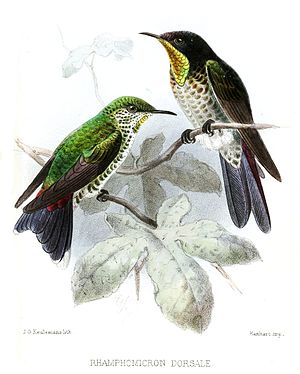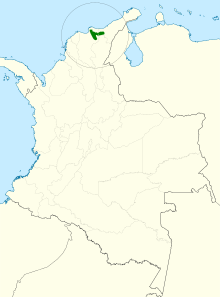Black short-billed hummingbird
| Black short-billed hummingbird | ||||||||||||
|---|---|---|---|---|---|---|---|---|---|---|---|---|

Black short-billed hummingbird painted by John Gerrard Keulemans |
||||||||||||
| Systematics | ||||||||||||
|
||||||||||||
| Scientific name | ||||||||||||
| Ramphomicron dorsal | ||||||||||||
| Salvin & Godman , 1880 |
The black short-billed hummingbird ( Ramphomicron dorsale ), sometimes called the black- backed hummingbird , is a species of bird in the hummingbird family (Trochilidae) that is endemic to Colombia in the Sierra Nevada de Santa Marta . The stock is on the IUCN as endangered ( Endangered estimated).
features
The black short-billed hummingbird reaches a body length of about 9 to 10 cm, with a weight of about 3.5 g. The male has a very short, slightly curved black bill. The top is velvet black with a white spot behind the eye. The tips of the upper tail-coverts are violet-bronze in color. The throat collar is olive green, the rest of the underside is dark gray with a reddish brown mixture and green sequins . The purple-black tail is of medium length and forked deeply. The outer control springs are a little wider. The upper side of the female has a grass-green shimmer. The upper tail-coverts are the same as in the male. The underside is yellow-brown with some green spots. The tail is similar to that of the male, but is slightly shorter. The outer control springs have white tips.
Behavior and nutrition
The black short-billed hummingbird gets its nectar from heather plants , coral trees , bluebells , black- mouthed plants , puya , red plants and sage . Usually he clings to the plant to take in nectar. Insects are picked from the leaves or chased in the air. He looks for his food from the lower strata to the treetops.
Vocalizations
Little explored the song of the black short-billed hummingbird. His sounds contain short, dry, rattling trrr tones that he repeats at intervals. It also emits a long, decreasing rattle, which ends with a few individual tsi-tttrrrrrrrr-tsi tones. You can also hear individual tsi sounds from him.
Reproduction
The breeding biology of the black short-billed hummingbird has not yet been researched or there are no data available.
distribution and habitat
The black short-billed hummingbird prefers the edges of damp elven forests and páramo at altitudes from 2000 meters to the snow line at 4500 meters.
Etymology and history of research
The first description of the black-footed hummingbirds carried out in 1880 by Osbert Salvin and Godman Frederick DuCane under the scientific name Ramphomicron dorsal . The type specimen was collected by Frederic AA Simons in Sierra Nevada de Santa Marta. Charles Lucien Jules Laurent Bonaparte introduced the genus Ramphomicron as early as 1850 . Ramphomicron is derived from the Greek words »rhámphos ράμφος « for »beak« and »mikron μικρὸν « for »small«. The species name "dorsale" is derived from the Latin "dorsualis, dorsum" for " dorsal , back".
Web links
- Ramphomicron dorsale inthe IUCN Red List of Threatened Species 2019.2. Listed by: BirdLife International, 2016. Retrieved November 5, 2019.
- BirdLife International: Species Factsheet - Black-backed Thornbill ( Ramphomicron dorsale ) . Retrieved November 5, 2019.
- Videos, photos and sound recordings of Black-backed Thornbill (Ramphomicron dorsale) in the Internet Bird Collection
- Black short-billed hummingbird ( Ramphomicron dorsale ) at Avibase; accessed on November 5, 2019.
- Ramphomicron dorsale in the Integrated Taxonomic Information System (ITIS). Retrieved November 5, 2019.
- xeno-canto: Sound recordings - Black short-billed hummingbird ( Ramphomicron dorsale )
- Black-backed Thornbill (Ramphomicron dorsale) in the Encyclopedia of Life . Retrieved November 5, 2019.
literature
- Thomas Züchner, Peter Boesman in: Josep del Hoyo , Andrew Elliott, Jordi Sargatal , David Andrew Christie , Eduardo de Juana: Black-backed Thornbill (Ramphomicron dorsale) In: Handbook of the Birds of the World Alive . Lynx Edicions, Barcelona.
- James A. Jobling: Helm Dictionary of Scientific Bird Names . Christopher Helm, London 2010, ISBN 978-1-4081-2501-4 .
- Osbert Salvin, Frederick DuCane Godman: On the birds of the Sierra Nevada of Santa Marta, Colombia . In: The Ibis (= 4 ). tape 4 , 1880, p. 169-178 ( biodiversitylibrary.org ).
- Charles Lucien Jules Laurent Bonaparte: Conspectus generum avium . tape 1 . EJ Brill, Leiden 1850 ( biodiversitylibrary.org ).
Individual evidence
Remarks
- ↑ Bonaparte ordered the genus to the following types: purple-backed thornbill ( Ramphomicron microrhynchum ( Boissonneau , 1840)), bronze-tailed thornbill ( Chalcostigma Heteropogon ( Boissonneau , 1840)), Chestnut Cap Glanzschwänzchen ( Chalcostigma ruficeps ( Gould , 1846)), emerald-chinned hummingbird ( Abeillia abeillei ( Lesson, RP & Delattre , 1839)), black-eared hummingbird ( Adelomyia melanogenys ( Fraser , 1840)) (= Syn: Trochilus sabinae Bourcier & Mulsant , 1846), black-eared hummingbird ( Adelomyia melanogenys inornata ( Gould , 1846)).
